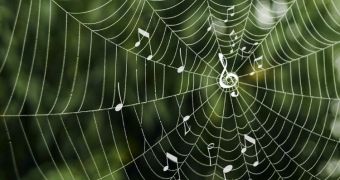Researchers at the Massachusetts Institute of Technology (MIT), in Cambridge, announce the creation of a new mathematical model, which provides a solid theoretical foundation for analyzing the way in which structures relate to form in things as different as spider silk is from music.
What the team has shown is that the nature of this relation is consistent throughout, regardless of the specific area, object or phenomenon to which it applies. In this manner, the sonic structure of a song is equally relevant to its function as the physical structure of a spider web is to its own purpose.
With the new model, it may become a lot easier for experts to compare research findings from disparate scientific fields, in order to gain a more holistic view of the concepts being discussed. Determining structure-function relationships is a very complex endeavor regardless of where it is applied.
However, experts may now learn new research techniques for analyzing structures, such as for example analyzing the basic building blocks of any object or phenomenon, before moving on to more complex organizations.
In the new study, the MIT group started by analyzing amino acids and sound waves, which were the basic structures involved in spider silk and music, respectively. By understanding the very foundations of something, it may then be possible to compare it to seemingly-unrelated items or phenomena.
Scientists now believe that it may be entirely possible to have material engineers create new compounds that take inspiration directly from how nature organizes molecules in some of the toughest structures that occur on Earth.
Spider silk is one these products, since a single strand from a spider web is three times stronger than s steel wire of the same width. Replicating this toughness at larger scales could lead to the development of new materials. The chemicals that allow geckos to walk on glass may also be replicated.
Conversely, it may also become possible to use music and other forms of art to understand the complex structure-function relationship that develop within biological systems such as ourselves. This could make it easier for biologists to understand how we – and other species – work.
The MIT team was made up of Department of Mathematics postdoctoral researcher David Spivak, Department of Civil and Environmental Engineering (CEE) associate professor Markus Buehler and CEE graduate student Tristan Giesa.
Details of their model appear in the December issue of the esteemed journal BioNanoScience.
“There is mounting evidence that similar patterns of material features at the nanoscale, such as clusters of hydrogen bonds or hierarchical structures, govern the behavior of materials in the natural environment, yet we couldn’t mathematically show the analogy between different materials,” Buehler explains.
“The [ontology logs] lets us compile information about how materials function in a mathematically rigorous way and identify those patterns that are universal to a very broad class of materials,” he adds.
“Its potential for engineering the built environment – in the design of new materials, structures or infrastructure – is immense,” the MIT associate professor concludes.

 14 DAY TRIAL //
14 DAY TRIAL //